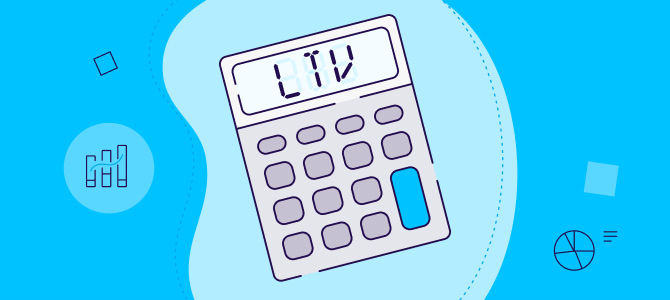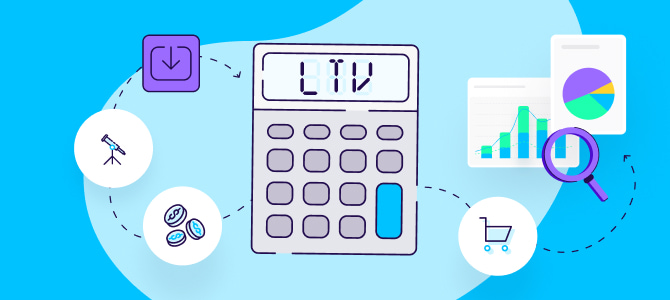Lifetime value, or LTV, is an estimate of the average revenue a customer will generate over the time that they use a given product or service.
What is LTV?
Lifetime value, or LTV for short, is a core metric in mobile business growth, often used to determine how valuable a user is over the span of time that they’re using an app.
LTV helps marketers properly optimize revenue streams like in-app purchases, in-app advertising, and subscriptions, by pinpointing exactly how much money they can afford to spend on user acquisition while remaining profitable.
LTV vs CLV
You may also have heard the term CLV, or customer lifetime value, and be wondering how it differs from LTV. In truth, the two metrics are very similar, and in some companies the terms are used interchangeably.
If you want to get technical about it, though, it’s generally agreed that CLV measures the value an individual customer will bring over the time they spend with you, whereas LTV looks at the average value across your entire customer base.
What about ARPU?
ARPU — average revenue per user — is another metric you’ll hear mentioned a lot in the context of customer value.
Where it differs from LTV is in the timeline. Whereas LTV looks at the value a customer brings over their entire interaction with your brand (whether that’s days or years), ARPU focuses on a defined time period. You might want to measure revenue over a particular month, or examine how customers behave 30 days after install, for example.
Here’s how to work it out:
ARPU = total business revenue over a set period / average number of users in that period
How to calculate LTV
There are lots of formulas around for calculating LTV. Here are a few simple steps you can follow to quickly pinpoint your number:
- Determine your average purchase value. If you haven’t been measuring your average purchase data for a while, consider looking at a one- or three-month period as a proxy for the full year.
- Calculate the average number of purchases during a defined period. Frequency of app usage is a major driver of LTV.
- Measure your user retention. Figure out how long the average user sticks with your brand. Some brands manage to inspire lifelong loyalty, but most struggle to keep users hooked because of a poor user experience (UX) or a brutally competitive landscape.
- Calculate away! Now that you have the inputs, it’s time to multiply the three numbers together and put all that goodness into a simple formula:
LTV = Average purchase size x Number of purchases x Retention period
Or try this one instead:
LTV = Total revenue generated since install date or during a defined period / Total number of users who installed on that date or during the set period
Why is LTV important?
Combined with the average revenue per user, LTV is a golden metric to determine the total prospective revenue or value of your users. In the free-to-install app economy, it’s an essential way to measure business health.
Here are some more reasons why it’s so important to measure LTV:
- You can’t improve what you don’t measure. Once you begin measuring LTV and breaking down the various components, you’ll be able to employ more targeted strategies around pricing, advertising and user retention. This will help you achieve your goals of continuously improving your UX and increasing profit.
- Make better user acquisition decisions. When you know what to expect in terms of average earnings per user, you can increase or decrease spending to ensure you maximize profitability and continue to attract the right audience.
- Improve forecasting. LTV predictions can help you make forward-looking decisions around ad spend. LTV forecasting minimizes the risk of underspending and missing out on potential business, or overspending and wasting your money in the wrong places.
- Boost customer loyalty and retention. When a company consistently provides value — in the form of a great, intuitive app, outstanding customer support, or an excellent loyalty program — customer loyalty and retention tend to soar. Focusing your efforts on users with higher LTV will enable you to drive retention. More loyal users means lower churn rate, as well as more referrals and positive reviews.
- Drive recurring purchases. LTV allows you to measure web visits or app usage per year or over your users’ lifetime. You can then use that data to implement strategies that increase repeat business.
- Charge up profitability. Overall, higher LTV leads to bigger profits. By keeping users for longer stretches of time and building a model that encourages them to spend more, you should see the benefit show up on your bottom line.
LTV for SaaS businesses
LTV is particularly relevant for SaaS (software as a service) businesses, where success depends on building lasting customer relationships.
In a competitive marketplace, you’ll need to spend some money convincing customers to choose your product. For your business to be profitable, you need those customers to stay with you and increase their spend, for example by upgrading to premium features.
It’s vital to understand not just how much value customers bring you over time, but how much you spent to acquire them. That way, you can identify the most effective acquisition strategies and the most lucrative relationships to focus on. Below, we help you figure out the perfect balance.
LTV and CAC: the magic number
Your LTV:CAC ratio allows you to compare the lifetime value of your customers with your customer acquisition cost (CAC).
To work out your CAC, divide your total marketing expenses by the number of customers you’ve acquired.
Your LTV:CAC ratio is calculated as LTV / CAC. This can be expressed as a ratio, for example 4:1.
If your result is below one, you have a problem: your customers are effectively losing you money. Generally speaking, a good LTV:CAC ratio is at least 3:1 (in other words, your LTV is at least 3x your CAC). Too low, and you could struggle to recoup your acquisition costs over the customer lifetime. A very high number, on the other hand, suggests you’re great at retaining customers — but could be missing opportunities to attract more of the right ones.
LTV reports vs. activity reports
Data reports sit at the heart of the mobile marketing operation. Without them, it’s impossible to make data-informed decisions that are vital to the success of your business.
That said, and much like other elements of the mobile landscape, data is multi-faceted. When it comes to LTV, data reports come in two main forms.
Lifetime vs. activity data
Let’s explore the two main methods for analyzing your users’ events data. By this, we mean any actions performed by users post-installation, such as in-app purchases, registrations, or level completions etc. Install data, on the other hand, is considered to be neither activity nor LTV data.
- Lifetime data includes all events performed throughout the lifetime of users who installed during a specific date range. Good campaign optimization depends on LTV data, as it allows you to keep track of the quality of users coming from different media sources.
- Activity data includes all events performed by all active app users during a specific date range, and shows an accurate breakdown of chronological events.
It’s a solid business metric that allows you to keep a finger on the pulse of trends — for example, how many app sales took place on Black Friday 2022 vs. Black Friday 2021. But marketers usually look at LTV data because they can isolate specific cohorts.
The train analogy can help explain the difference between the two:
Sam is standing next to a railway watching a train go by. During a single moment in time,Sam sees only the current actions performed by ALL of the passengers. This is activity data.
Now take David, who’s standing inside one of the railroad cars. David sees ALL the actions performed only by the passengers who boarded the train with him, from their arrival (i.e. install) until departure (i.e. uninstalling). He can’t see any action performed by passengers on other railroad cars, since they boarded either before or after him. This is LTV data.
LTV in the age of consumer privacy
While we can all agree that privacy is a blessing for both consumers and the mobile ecosystem, the changes that came in with iOS14 do bring their unique set of challenges.
Fortunately, SKAdNetwork 4.0 (SKAN 4.0), released in October 2022, offers marketers some improvements on the previous version. Before, you could only receive one postback, which was based on data signals from early on in the funnel like installs. There was little or no postback from in-app events, which are useful indicators in measuring LTV. This lack of data proved a real challenge for campaign measurement.
Now, SKAN 4.0 gives advertisers up to three postbacks, each based on a specific data window. There’s also a feature called LockWindow, which enables you to get postbacks sooner.
Apple’s crowd anonymity technology means the data you get from postbacks is limited: it shows the conversion value of the campaign, and can’t be linked to specific users. But you can overcome the data limitations by using predictive modeling tools. Below, we look at how these can help you optimize your campaigns effectively and safely.
Predicting the future with pLTV
It’s useful to see how much value your customers have brought in the past — but wouldn’t it be more powerful to know how they’ll behave in the future? With predicted lifetime value (pLTV), you can do just that, without the need for a crystal ball.
pLTV is a form of modeling that uses machine learning and artificial intelligence (AI) to predict future actions based on past data. It enables you to segment your customers based on how they’ve interacted with your business — so you can see early on which campaigns, channels and strategies are the most profitable, and where to focus your efforts going forward.
A big benefit of this approach is that it keeps you on the right side of the heightened privacy guidelines: you only need to know what customers do, not who they are.
How can you improve LTV?
There are loads of different strategies that can help you boost your LTV. We’ve gathered a lucky 13 for you to consider:
1. CX – customer experience is everything
Your app, website, customer care and other touchpoints are all part of your unique CX. If your customers enjoy a smooth, low-stress digital experience every time, they’re much more likely to come back again, spread the good word about your brand, ramp up your app store ranking, and boost your organic growth.
2. Improve your onboarding
Some consumers buy a product or service but then have no idea what to do next. Successful brands chart a path for their customers’ journey, which starts by investing in an intuitive, smooth, and interactive onboarding experience.
This helps to ensure users come back frequently and use your app effectively, improving the likelihood of future upgrades or higher in-app spend.
3. Connect LTV to your attribution data
This joined-up approach will allow you to pinpoint the best channels, media sources, campaigns, and creatives to focus on.
4. Offer better value
By focusing on value and giving customers something they can’t get elsewhere, you’re much more likely to increase your LTV — and even pricing — while minimizing churn. Just be sure to consider your competitors’ pricing before determining your own.
5. Invest in customer loyalty or rewards programs
Rewarding your customers’ frequent purchases or long-lasting subscription will keep them feeling valued and engaged. Look for creative ways to incentivize your customers to return, increase their purchase frequency, and share the love with their friends.
6. Offer outstanding customer care
Poor customer service is a quick way to see your LTV drop and churn rates soar. Focusing on making every customer care interaction a delightful one will further enhance your customer loyalty and help you ramp up your LTV.
Also, don’t forget to loop in your customer feedback. In addition to relying on customer care to fix the problem, brands need to continuously gather feedback to be able to link it into their regular product or service iterations, and enhance their CX.
7. Design a better experience
Is there anything more frustrating than a website or app where you can’t immediately find the button you need?
If your website or app is cluttered, hard to navigate, or slow to load, users are unlikely to stick around. Keep your design clean and on-brand for a consistent user experience. Test it on different devices, and follow best practices for accessibility — for example, avoid lengthy scrolling and ensure links and calls to action stand out clearly.
8. Ensure your purchasing experience is smooth
Cart or checkout abandonment is a real and painful problem for most businesses. Building a short and simple purchase experience will help you capture every possible sale. Where purchases are abandoned, consider a follow-up email to nudge your potential customer to the checkout.
9. Encourage upsells and cross-sells
It’s often easier (and cheaper) to re-engage or upsell an existing customer than bring in a new one. Find creative ways to highlight the added value of higher-end or additional products, encouraging your customers to spend more.
10. Be present on social media
One of the best places to get your customers’ attention is to reach them in places where they’re already spending most of their time. Whether it’s TikTok, Instagram, LinkedIn, Snapchat, Twitter or Facebook, social media channels are impactful for both advertising and interacting with your customers.
11. Offer relevant and engaging content on your owned media channels
Your owned media — which includes your website, blog posts, e-books, videos, podcasts and social media content — can help you connect with particular segments of your audience, introduce them to new products or encourage optimized usage.
12. Boost retention with push notifications
Used properly, push notifications can be a great way of reminding users of the benefits of your app and encouraging them to access it more often. These short, clickable messages are sent by the app directly to the user’s device.
But don’t become a pest, or your retention efforts will drive users away. Push notifications will only work if they’re relevant, useful and sent at the right time: for example, alerting users to a limited offer or reminding them to do a daily activity. Crucially, users also need to have opted in to receive them.
13. Test, test, test
Improving your LTV is all about understanding what your customers want. You can use A/B testing at every stage of your user journey to find out what drives the most conversions. By comparing how users respond to different headlines, calls to action, layouts, images, and more, you’ll be able to optimize future campaigns for maximum revenue.
Frequently asked questions
What does LTV stand for and why is it important?
LTV stands for lifetime value, a metric used to assess the total value a user brings over their entire lifespan using an app (or any other product or service). A valuable indicator of business health, it’s crucial for optimizing revenue streams and guiding user acquisition spending to ensure profitability.
How can you calculate LTV?
To calculate LTV, you can multiply the average purchase size by the number of purchases and the retention period. Alternatively, divide total revenue by the total number of users for a specific period.
What’s the difference between LTV and CLV?
LTV and CLV (customer lifetime value) are similar, measuring the value a customer brings over time. However, LTV generally refers to the average value across all customers, while CLV focuses on the value of an individual customer.
What’s the difference between LTV and ARPU?
ARPU (average revenue per user differs from LTV in its timeframe, focusing on revenue during a specific period rather than the entire span of a customer’s interaction with a brand.
Why is LTV crucial for SaaS businesses?
For SaaS companies, understanding LTV helps balance acquisition costs with long-term customer value, so you can optimize for the most effective acquisition strategies and the most lucrative customer relationships.
What is the LTV:CAC ratio?
The LTV:CAC ratio compares lifetime customer value to customer acquisition cost, telling you how profitable your customers are relative to the cost of acquiring them. A good ratio is at least 3:1, while a negative number would mean your customers are losing you money.
pLTV stands for predicted lifetime value. It’s a form of modeling that uses machine learning and AI to predict how customers will behave in the future, based on past data. This is a privacy-safe way to identify the most effective future strategies.
Enhancing customer experience, optimizing onboarding, linking LTV to attribution data, offering more value, investing in loyalty programs, and ensuring excellent customer service are key strategies to boost LTV.
Key takeaways
- LTV is a critical metric in growing your mobile app business. It helps you properly optimize campaigns by pinpointing exactly how much money you can afford to spend on user acquisition while remaining profitable.
- Related metrics include CLV (customer lifetime value), pLTV (predicted lifetime value), and ARPU (average revenue per user).
- Measuring LTV can help you be more strategic around pricing, advertising, and user retention. It enables you to make better user acquisition decisions, improve forecasting, boost customer loyalty, drive recurring purchases, and charge up profitability.
- To ensure a profitable balance between acquisition costs and lifetime value, aim for an LTV:CAC ratio of at least 3:1.
- By harnessing machine learning algorithms, digital marketers are able to overcome some of the privacy limitations posed by Apple’s SKAdNetwork, make more sense of user behavior trends, and use these to predict user value over time.
- Ways to improve LTV include offering more value, acting on customer feedback, and providing outstanding customer care. You should also share relevant content through your owned media channels, use push notifications, and keep testing to optimize your design.











